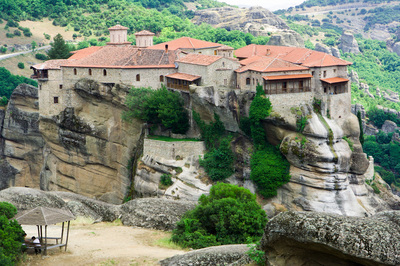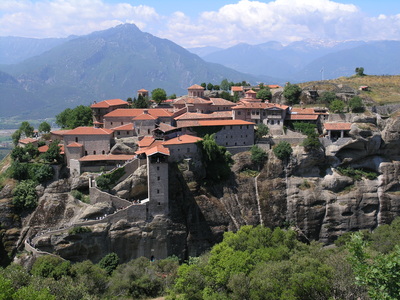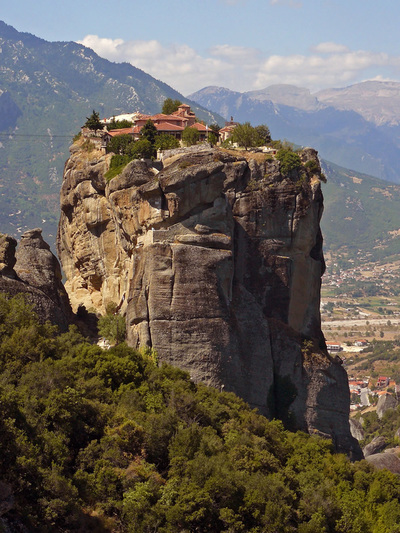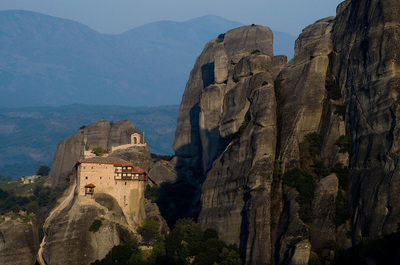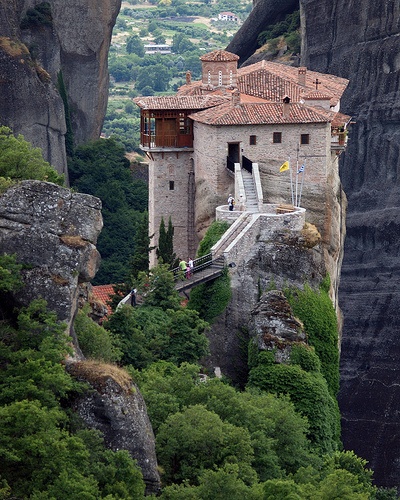Meteora [pronounced "Me-té-ora"] Μετέωρα
|
|
Second to Mt. Athos , Meteora is the densest collection of spiritual communities. The word "meteora" means "suspended in air". Unlike Athos, Meteora is open to women visitors. At one time there were 20 working monasteries; today only 6 are active; they survive from tourism and see thousands of pilgrims each year. You will remember the scenes from the James Bond movie “For Your Eyes Only” where the bad guy hides out on Meteora. Go to Netflix to experience the beauty of the buildings that sit atop the rock mountains which are accessible by over 700 steps.
There are a few theories about how Meteora was created. We know that around 60 million years ago the area was covered with sea water. Geologists believe it was a river fed by a number of mountain streams. The rocks are a mass of river stones, sandstone, and pebbles all joined together like cement. Perhaps a strong earthquake emtpied water from the river, and the rocks took final shape from millions of years of the interaction of wind, sand, and ice. The highest peaks are about 300 meters (1,300 feet). |
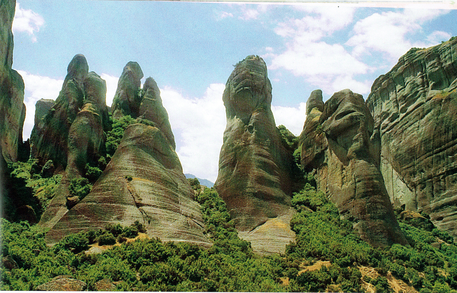
There are a few theories about how Meteora was created. We know that around 60 million years ago the area was covered with sea water. Geologists believe it was a river fed by a number of mountain streams. The rocks are a mass of river stones, sandstone, and pebbles all joined together like cement. Perhaps a strong earthquake emtpied water from the river, and the rocks took final shape from millions of years of the interaction of wind, sand, and ice. The highest peaks are about 300 meters (1,300 feet).
For thousands of years hermits took up residence in the Theopetra caves, about 3 miles from Kalampaka. In the 9th c. a group of hermit monks in search of peace and isolation from the Byzantine Empire climbed the rocks of Meteora and began to live in the rock fissures. Gradually they built the dwellings and churches that evolved into monastic communities. The feat of building on the steep precipices was glorious, dangerous and innovative!. Materials were hauled up on rope and wooden ladders and by an ingenious pulley system of rope baskets between the rocks and to make the vertical ascents and descents from them. Until stone steps on tree-lined winding paths were built to reach each monastery, monastics and visitors were pulled up in these rope baskets. We have no statistics on how many people died during the construction of or movement about these magnificent places.
The first community was Great Meteora (c.1340). By 1500 there were 24 monasteries 1500, flourishing until the 17th century. Only six survive today and are inhabited by monks and nuns (4 monasteries and 2 convents). Like a city in a stone forest of rocks, the Monastery of St. Stephen on the Eastern side of Meteora is the only one visible from Kalampaka. We are able to drive almost to the gate of the Monastery of Agios Stephanos (St. Stephen's), crossing from the road across a steel walking bridge to the outer visitor center building.
Meteora was declared a World Heritage site in 1988 and in 1991 a sacred/holy place by Greece.
These are the six open monastic communities. The town of Kalampaka and Meteora were bombed during WWII and only these communities remain. We wind up to the top on a clear and cool day day. Our guide relates that from the 4th to 15th c. all Orthodox could circulate freely during Byzantine rule.
(On the next two pages are details and images from the two monasteries we visited: the Monastery of Agios Stephanos and the Monastery of Rousanou.)
For thousands of years hermits took up residence in the Theopetra caves, about 3 miles from Kalampaka. In the 9th c. a group of hermit monks in search of peace and isolation from the Byzantine Empire climbed the rocks of Meteora and began to live in the rock fissures. Gradually they built the dwellings and churches that evolved into monastic communities. The feat of building on the steep precipices was glorious, dangerous and innovative!. Materials were hauled up on rope and wooden ladders and by an ingenious pulley system of rope baskets between the rocks and to make the vertical ascents and descents from them. Until stone steps on tree-lined winding paths were built to reach each monastery, monastics and visitors were pulled up in these rope baskets. We have no statistics on how many people died during the construction of or movement about these magnificent places.
The first community was Great Meteora (c.1340). By 1500 there were 24 monasteries 1500, flourishing until the 17th century. Only six survive today and are inhabited by monks and nuns (4 monasteries and 2 convents). Like a city in a stone forest of rocks, the Monastery of St. Stephen on the Eastern side of Meteora is the only one visible from Kalampaka. We are able to drive almost to the gate of the Monastery of Agios Stephanos (St. Stephen's), crossing from the road across a steel walking bridge to the outer visitor center building.
Meteora was declared a World Heritage site in 1988 and in 1991 a sacred/holy place by Greece.
These are the six open monastic communities. The town of Kalampaka and Meteora were bombed during WWII and only these communities remain. We wind up to the top on a clear and cool day day. Our guide relates that from the 4th to 15th c. all Orthodox could circulate freely during Byzantine rule.
(On the next two pages are details and images from the two monasteries we visited: the Monastery of Agios Stephanos and the Monastery of Rousanou.)
next....
